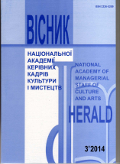ТИПОЛОГІЯ КУРАТОРСТВА:
ІСТОРИЧНІ ПРОТОТИПИ ТА СУЧАСНА ТЕРМІНОЛОГІЯ
The typology of curating: historical references and modern terminology
Author(s): Ielyzaveta GermanSubject(s): Museology & Heritage Studies, Visual Arts
Published by: Національна академія керівних кадрів культури і мистецтв
Keywords: curator; exhibition history; exhibition-making; museum of contemporary art; Harald Szeeman;
Summary/Abstract: Like any other artistic profession curating hasn’t been a homogeneous practice since its formation in late 1960’s. In different times curatorial style was influenced by the new socio-economical circumstances of the art system as well as the changing nature of contemporary art in general. As far as the curatorial impact becomes more visible at the Ukrainian art scene, the local art historical field demands an adequate critical apparatus of curatorship based on international experience and recent theoretical elaborations. The selected papers of foreign authors on curatorial theory and history can be divided into several main directions according to chosen subject of research: the evolution of art exhibition (B. Altschuler, R. Greenberg, W. Grasskamp, B. O’Doherty, D. Richter), museum projects (T. Benett, L. Alloway. K. Schubert), emerging curatorial strategies (K. Bokhorov, B. von Bismarck, B. Groys, C. O’Doherty, P. O’Neill). Important professional insights can also be found in texts and statements of some prominent curators (H. Szeemann, S. Sigelaub, V. Miziano, L. Lippard, M. Lind, H.-U.Obrist). The tendencies of Ukrainian curating are slightly touched in some writings of O. Solovjov, K. Botanova and O. Ostrovska-Lyuta.Despite rather diverse coverage of historical panorama of curating, there is an obvious lack of its precise classification and argumentative definitions. The goal of this paper is to present the range of most important curatorial modes in the second half of 1960-2010’s.The term "curator" comes from English language and has Latin roots. In times of Roman Empire curator was a title given to officials responsible for food provision and various civil affairs (D. Levi Strauss). During the Enlightment period curators were involved in scientific experiments. In times of Luis XIV, who initiated first group exhibitions ("salons") of Royal academy members, curator acquires its artistic sense and becomes responsible for hanging paintings (K. Bokhorov). In late XIX – early XX century art exhibitions were usually "curated" by art-critics (i.e. Felix Feneon, Roger Fry) or by artists themselves (Impressionists groups). The tradition of artistic self-organization remained vital in avant-garde circles in 1900-1910 (exhibitions of Die Bruecke and Der Blaue Reiter groups, Italian Futurists group, "The last futurist exhibition. 0.10" etc.) (B. Altshuler). In 1920-30’s artists (i.e. Friedrich Kiesler, Herbert Bayer) were often engaged as authors of exhibition design for large-scale exhibitions within World trade fairs (M. A. Staniszewski).The modern meaning of the curatorial profession became legitimate in 1960’s and was associated mostly with museum keeper until 1990’s (R. Fleck). However, in 1960–70’s the curatorship also emerged as an independent activity beyond institutions. In fact, since 1960’s curatorship was divided into 2 main directions: museum or institutional curator and independent curator.The responsibilities of museum curator are focused on several main issues: acquiring new works for collection, researching and exhibiting its parts (L. Alloway); improving museum’s position and collection by fundraising and political communication, satisfying public demands for education and entertainment (K. Schubert).Suggested division to museum and independent directions is fairly conditional, as practically many curators work in both directions. One of the first independent curators Harald Szeemamn started his autonomous activity after he left the director’s position in Kunsthalle Bergen. Szeeman himself defined his occupation as exhibition-maker (Ausstellungmacher in German) and since 1969 organised all his projects under the banner of self-initiated one-person-institution The Agency for Spiritual Migrant Work (D. Levi Strauss, H.-U. Obrist). Another important independent curator of 1960’s generation, Seth Sigelaub, described the role of the curators as those who have to "demystify" the rigid art institutions and thus to make the mechanisms of art production, display and distribution visible (P. O’Neill). Both of them, as well as most of their contemporaries, developed their exhibition strategies according to the recent artistic ideas (like conceptualism, land art etc.).During the 1990’s another type of curating has emerged. The biennial curating of large-scale international exhibitions is aimed at combining previously unrelated local art trends in order to rethink existing geopolitical configuration of the art world, as it was done in Jean-Hubert Martin’s (1989) and Okwui Enwezor’s (2002) projects (P. O’Neill, F. and V. Martini).Among the recent innovative modes we distinguish performative and post-representational approaches. Performative curating deals with an exhibition as an autonomous "living" medium of its own that has no final shape and may be transformed while it is on stage. This type of curatorial thinking is influenced by "relational aesthetics" artistic strategies dealing with time-based events rather then executed objects (A. Farquarson). Post-representational curating denies the format of a static display at all and prefers discursive events with a strong educational elements and active audience engagement (N. Sternfeld, L. Ziaja, I. Rogoff).The abovementioned ideas can be summarized as following: 1) the curatorial practice since its establishing in 1960’s has been always closely linked to current artistic innovations; 2) the curator as an important figure of artistic scene has become a new type of postmodernist author with its own creative and intellectual impact.
Journal: Вісник Національної академії керівних кадрів культури і мистецтв
- Issue Year: 2014
- Issue No: 3
- Page Range: 197-203
- Page Count: 7
- Language: Ukrainian

